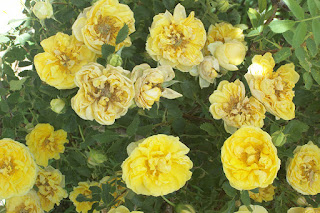| I can't remember a time when I didn't love roses. They are the sight and scent of family, of comfort, and all things beautiful. That I have dozens of them comes as no surprise to anyone that knows me well. What I didn't know was that my neighbor was jealous of my roses. He finally made his way cautiously over while I was trimming my roses back this spring and asked how I was able to make them bloom so profusely. I had to (awful of me) stare for a moment, taking in the question, before answering, "You have to love on them. Take care of them from spring to fall." This guide shows how to properly trim your blooming roses (deadhead is the proper term for the process). Not only does it make for a healthier rose bush, but it encourages more blooms. The rose illustrated was wild when I moved in, and has since grown into a sprawling bush that literally drips with yellow roses. |
||||||||||
 |
||||||||||
Materials Needed:
|
||||||||||
 |
||||||||||
|
||||||||||
 |
||||||||||

 
 |
||||||||||

DIY tutorials, guides, and resources feed our curiosity - part of the art and craft of living a luxurious life. A luxurious life is one well spent, appreciating and creating beauty in all its forms. Wherever your creative curiosity lies, you're sure to find a how-to here that leads to your own luxurious life.
6.10.2013
Dead-Heading Roses & Rose Tea
6.08.2013
Upcoming Projects
When beginning Curious Kitty, I simply had a need to share. Two days after starting, my computer went through a massive hard drive failure. Always fun. So ... I'm running a little behind where I wanted to be at this point.
With that in mind, I thought it might be nice to have a sneak peek at some of the projects currently in draft state. Keep in mind that the photos below represent the original project and won't necessarily represent what we create together. It's a sneak peek, after all :)
And there are some other things in the works, as well. Living in the Rocky Mountains, we have a few precious months of sunshine where construction can be done and this summer is overloaded with it. A total frame-off restore of the house, including windows, and interior remodeling are going on - most of it by the hands of myself and my family.
So you're going to get to learn with me some cool things like how to make a fold-away-desk on (yes, on) a bed, how to texture and fix drywall, and a myriad little projects like making trinket shelves and an entire walk-in art studio as part of a bedroom. Yup. Lots planned, so please bear with me when there are a day or two that pass with no posts. This blog is going nowhere - you're stuck with the Curious Kitty poking her nose in all corners of a Luxurious Life!
6.07.2013
Embroidery Basics: The Straight Stitch
| The Straight Stitch is the most basic of all stitches, used both in hand sewing and embroidery. It is considered by many to be the most important stitch to learn and feel comfortable with first. Knowing how to do a straight stitch is a fundamental. A total novice who has never held needle and thread in hand can create a straight stitch - and once you have the spacing down, you can use this single stitch to create a wide variety of effects in your embroidery. |
||||||||||||
 |
||||||||||||
Materials Needed:
The materials above are for practicing the straight stitch using the Print & Practice Card provided. You can print as many copies as you like and practice until you feel comfortable. Then, you should move on to using embroidery floss and fabric. It is recommended that you use an embroidery hoop at this point, but not vital.
|
||||||||||||
|
||||||||||||
Alternatively, capture your chosen fabric in an embroidery hoop.
|
||||||||||||
Standard embroidery floss has 6 strands of thread. Gently untwisting the thread will reveal the strands.
To the left, about 2 inches of thread hangs loose. At the end of the other length, make a simple knot.
|
||||||||||||
6.06.2013
Friendship Bracelet Tutorial: Chevron Stitch
| Every time I start a new friendship bracelet I have to giggle a little. As a young teen, these were all the rage and the more patterns you knew how to do from memory, the cooler you were. So totally. As friendship bracelets come back in fashion (did they really ever go away, though?), I've received more and more requests from young and older alike on how to make the evergreen piece of jewelry. Ask, and you shall receive! In this DIY guide, we're going to cover the straight-up traditional method of creating a friendship bracelet in a chevron pattern. There are more simple patterns ... but it really starts here if you're going for something more than one band of color after the other (and if that's what you're looking for, please leave a comment and I'll happily provide instructions on it, too!) |
||||||||||||||||||||
 |
||||||||||||||||||||
Materials Needed:
The materials above are for creating a 2-color chevron friendship bracelet. If you want more colors, go for it! You will need 12 strands total, so that gives you up to 6 color choices.
|
||||||||||||||||||||
 |
||||||||||||||||||||
|
||||||||||||||||||||
 |
||||||||||||||||||||
 The colors I've chosen make it a little difficult to see, but the arrangement (from the outside to the center) is: Left side: pink, gray, pink, gray, pink, gray Right side: pink, gray, pink, gray, pink, gray This makes a perfect mirror image with pink on the outside of both the left and right side and gray in the center.

At this point, it's difficult to see the pattern in the image but you can see how the threads have swapped and your color arrangement should behave much better.
 |
||||||||||||||||||||
Subscribe to:
Comments (Atom)

























